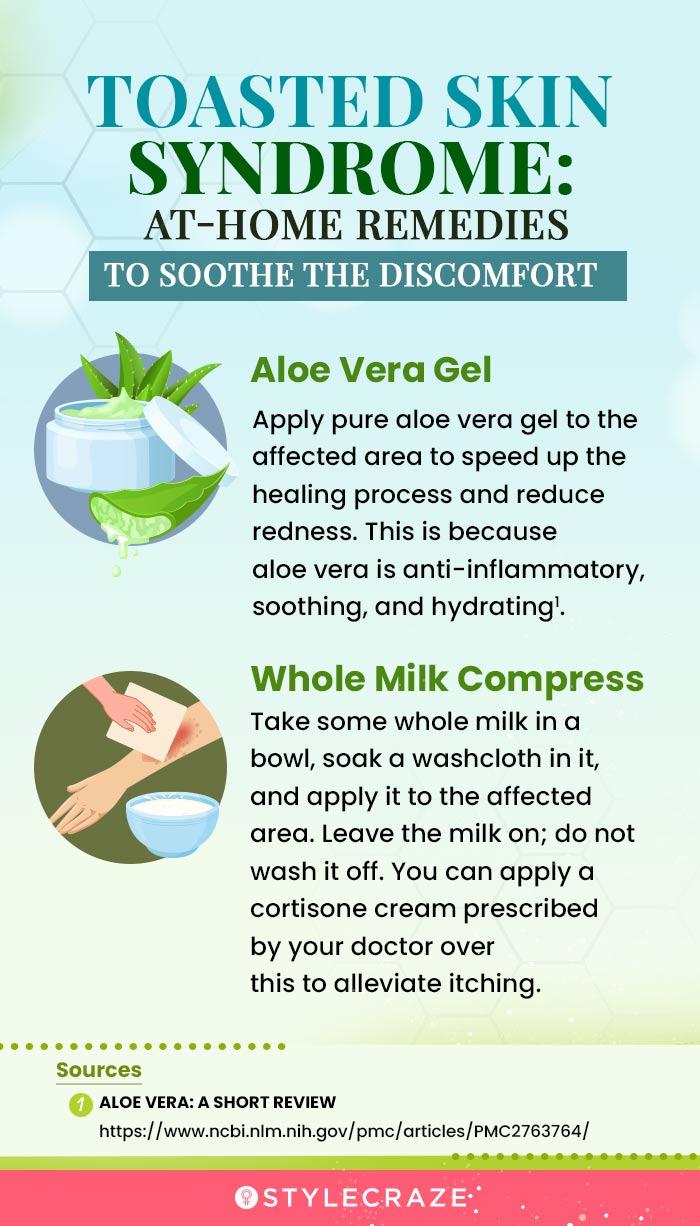Toasted Skin Syndrome – Causes, Symptoms, & Prevention Tips
Nothing can match the bliss of binge-watch your favorite shows while munching snacks, with the laptop resting on your thighs! But wait! If you often do that, you may get toasted skin syndrome!
It is a type of heat rash caused by prolonged heat exposure. You may develop the syndrome even from hot water bags or room heaters. It may not burn the skin but may damage superficial blood vessels. Keep reading to learn more about toasted skin syndrome, its causes, diagnosis, treatment, and prevention tips.
What Is Toasted Skin Syndrome?
Toasted skin syndrome or Erythema ab igne (EAI) is a medical condition characterized by erythema (patchy redness) and hyperpigmented rashes on the skin due to frequent and chronic exposure to heat, mainly infrared radiation (1).
Toasted skin syndrome occurs after chronic exposure to a low-heat source (around 109.4 to 116.6 °F) over a long period. This heat is below the heat levels that may cause a burn (2).
This syndrome was earlier associated with the elderly who spent a lot of their time sitting or standing too close to an electric space heater in cold countries. However, this condition is now also observed in people of all age groups. Apart from severely discolored net-like patches (due to hyperpigmentation), people with toasted skin syndrome may also experience itching, peeling, and burning sensations in the affected area.
Erythema ab igne may cause net-like patterns on the skin. However, it depends on the type of radiation and the skin contour. These rashes usually begin as a mild and localized lesion and often go unnoticed. On prolonged and repetitive exposure to the heat source, the lesion gains a more reticulate pattern and darkens due to increased pigmentation.

Did You Know?
The toasted skin syndrome is also called fire stains, granny’s tartan, hot water bottle rash, and laptop thigh.
Toasted skin syndrome is caused by exposure to any device or object that emits heat and infrared radiation.
Causes Of Toasted Skin Syndrome
Toasted skin syndrome is caused by exposure to any device or object that emits heat and infrared radiation.
Initially, toasted skin syndrome was caused by long-term exposure to:
- Open fire sources like stoves
- Bonfires or proximity to the fireplace
However, nowadays, any heat-emitting device may cause toasted skin syndrome. They include:
- Heat pads or hot water bags
- Electric heating blankets in hospital ICUs and hotels
- Electric and space heaters
- Infrared lamps (used for pain management)
- Laptops
- Seat heaters in cars
- Steam radiators
- Sauna belts
Applying heat due to relieve any symptom of an underlying medical condition may also cause toasted skin syndrome. It is usually observed in conditions like (3):
- Pancreatic pathology
- Carcinoma of kidney
- Hypothyroidism (rarely)
The signs and symptoms of toasted skin syndrome are very characteristic and can be easily identified.
Diagnosing Toasted Skin Syndrome: Signs And Symptoms
The symptoms of toasted skin syndrome primarily arise from cellular changes in the skin layers, similar to tanning or sun damage. The signs and symptoms include:
- Net-like pink patches (that may turn red)
- Dark or hyperpigmented patches
- Scaling
- Telangiectasia (spider veins)
- Burning sensation
- Itchiness
The dermatologist may do a quick physical examination to diagnose your condition. However, the symptoms of toasted skin syndrome can look similar to livedo reticularisi XA skin condition marked by reddish-blue discolorations in a net-like pattern that can occur due to swollen or constricted blood vessels. and poikilodermai XA skin disorder marked by atrophy, telangiectasias (spider veins), hypopigmentation, and hyperpigmentation. . Hence, the doctor may collect tissue samples for additional tests.
Some people are at greater risk of developing toasted skin syndrome due to several factors. Let’s take a look.
Who Are At Risk Of Developing Toasted Skin Syndrome?
Toasted skin syndrome is common in individuals who are exposed to high amounts of heat due to their occupation. They include:
- Bakers
- Chefs
- Factory workers (those who work in metal and coal factories)
Other people who are at risk of developing toasted skin syndrome include:
- People spending long hours in front of a fire
- Middle-aged and older adults who are more likely to spend their time in front of stoves or fireplace, or room heaters
- People undergoing medical treatment for conditions that require exposure to heat and radiation such as malignancies, musculoskeletal conditions, chronic pancreatitis, IBD (Inflammatory Bowel Disease)
- Youngsters and corporate workers who spend a large part of their time on the laptops resting on their thighs
- Silversmiths and jewelers
- Repeated use of furniture with in-built heaters
- Dentists or surgeons who work with powerful lights

 Trivia
TriviaTrivia
During the discovery of the toasted skin syndrome, a wood-burning stove was identified as the primary contributor to this skin rash.
Early diagnosis and treatment are crucial to heal toasted skin syndrome. Here is how you can manage this condition.
Treating And Managing Toasted Skin Syndrome
Mục Lục
1. Remove The Heat Source
Early diagnosis and treatment are crucial to heal toasted skin syndrome. Here is how you can manage this condition.
Avoid proximity to heating devices. Do not work with your laptop resting on your thighs. Maintain a safe distance and avoid constant exposure to fireplaces, infrared lamps, and other heating devices. Also, be careful when using a hot water bag – do not put it on bare skin. Use warm water instead of hot water and wrap a cloth around it to minimize damage.
Note: Newer sunscreens that offer infrared protection can help reduce the effect of heat. You can use physical sunscreens with zinc oxide and titanium dioxide.
2. Use Medication
The doctor will prescribe topical medications depending on the severity of your condition. They may prescribe:
- 5-fluorouracil for chronic cases of toasted skin syndrome
- Topical tretinoin to minimize hyperpigmentation
- Topical ointments with hydroquinone or other bleaching agents to manage pigmentary changes
The doctor may also prescribe therapies like:
- Laser therapy with ruby, alexandrite, or Q-switched Nd: YAG lasers to reduce pigmentation.
- Photodynamic therapy to rejuvenate the skin and reduce hyperpigmentation. However, its efficacy in treating this condition is still under study.
In some patients with erythema ab igne, the rash may turn into fluid-filled blisters. This is rare but usually indicative of lichen planus (an inflammatory condition of the mucous membranes) in the area. Toasted skin syndrome is a harmless condition. However, if not treated properly, it may lead to serious complications.
If ignored for long, toasted skin syndrome may lead to malignant transformation of the skin cells (4).
In many cases, patients with a history of erythema ab igne develop skin cancers after a latent period of a few decades.
Although it is rare, erythema ab igne may lead to squamous cell carcinoma (3). This is the second most common form of skin cancer that occurs due to damage caused by UV exposure and tanning beds. This slow-developing cancer may take a few decades to develop.
Erythema ab igne may sometimes mark internal malignancies, such as (5):
- Pancreatic adenocarcinoma
- Rectal carcinoma
- Gastric adenocarcinoma
- Hepatic metastases from primary lung cancer
Merkel cell carcinoma
i
X
A rare but aggressive form of skin cancer that generally develops in the sun-exposed parts of the body.
Lymphoma
i
X
Cancer of the lymphatic system, the body’s disease-combating network which consists of the thymus gland, spleen, and bone marrow.
If you experience chronic pain and toasted skin syndrome, consult a doctor immediately for proper diagnosis.
Infographic: Toasted Skin Syndrome: At-Home Remedies To Soothe The Discomfort
Treat your skin with extra caution if it displays signs of toasted skin syndrome. It may appear severe now, but it will improve over time. Just stop exposing that area of your skin to heat.
To treat your skin that has been harmed by heat and is experiencing toasted skin syndrome, you don’t need any pricey skin care creams or ointments. Instead, you can use simple remedies to improve the state of your skin right away. Check out the infographic below to learn more. Save
Save
Save the high-quality PDF version on your device now.

Toasted skin syndrome is a common occurrence. We unknowingly expose our skin to a constant heat source, especially when working on a laptop kept on the thighs or heat radiated from electric heaters and stoves during the winters. We may enjoy the warmth, but little do we realize that the heat damages the skin tissues and may cause redness, itching, and skin peeling. Therefore, avoid constant heat exposure, and whenever you notice any changes in the skin texture, consult a doctor. Also, toasted skin syndrome may indicate an underlying health condition. Make sure you go for a thorough checkup to determine the exact cause and start treatment.
Frequently Asked Questions
Is toasted skin syndrome rare?
Yes, toasted skin syndrome is considered a rare skin condition. It is more prevalent in women than men and in people suffering from chronic pain (4).
How long does toasted skin take to heal?
Once you remove the heat source, toasted skin syndrome may go away on its own within a few weeks or months (4). Consult your doctor for better understanding and treatment.
Key Takeaways
- Toasted skin syndrome is a medical condition that results in red patches and burning sensations all over the skin due to constant exposure to a heat source.
- Laptops, heat pads, sauna belts, and space heaters are some causes of toasted skin syndrome.
- People such as chefs, bakers, and jewelers are at a higher risk of developing it.
- Staying away from the heat source and using topical creams are some simple ways of treating toasted skin syndrome.
Sources
Articles on StyleCraze are backed by verified information from peer-reviewed and academic research papers, reputed organizations, research institutions, and medical associations to ensure accuracy and relevance. Read our editorial policy to learn more.
- Erythema ab igne (Unilateral) due to “Chulla”
https://www.mjdrdypu.org/article.asp?issn=0975-2870;year=2014;volume=7;issue=4;spage=529;epage=530;aulast=Kar;type=3 - Laptop-induced erythema ab igne: Report and review of literature
ttps://escholarship.org/uc/item/4n04r793 - Erythema ab igne: Usual site
unusual cause - Erythema Ab Igne: A Rare Presentation of Toasted Skin Syndrome With the Use of a Space Heater
https://www.ncbi.nlm.nih.gov/pmc/articles/PMC7971733/ - When erythema ab igne warrants an evaluation for internal malignancy
https://onlinelibrary.wiley.com/doi/full/10.1111/ijd.12329
Was this article helpful?
Related
The following two tabs change content below.
- Reviewer
- Author
![]()
Dr. Swati Mutha
Dr. Swati Mutha is a clinical and aesthetic dermatologist with over 10 years of experience. She has done her fellowship in Pediatric Dermatology from Singapore. She is a part of the Indian Dermatologist Association(IADVL) and has presented several papers and given lectures at national dermatology conferences. She practices at Assure Clinic, Breach Candy, and is also a consultant at ACI… more

Ramona Sinha
Ramona is an editor at StyleCraze with 11 years of experience in writing and editing. She has authored over 200 articles on skin and hair care. She graduated from the University of Calcutta, West Bengal, and did her post-graduation from the University of Kalyani, West Bengal. She also did a certificate course in dermatology offered by the Novosibirsk State University… more








